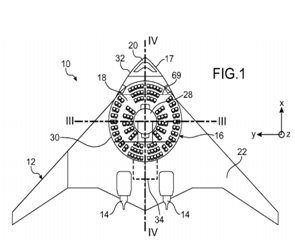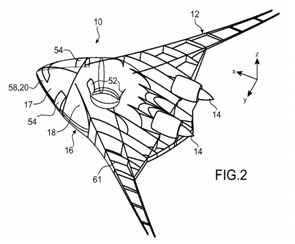15/12/2014
Is it a bird? Is it a plane? Is it…a bagel with wings? Airbus seeks US patent for revolutionary aircraft design that looks more UFO than conventional airliner.


Dubbed “the flying doughnut” in the UK press, you might be forgiven for wondering whether the latest innovation from the aerospace and defence giant Airbus resulted from a hungry pre-lunch brainstorming exercise rather than from the need to solve any particular technical problem. However, according to the US patent application filed in April and published at the end of October, the radical shape has a purpose and is directed at addressing the difficulty of pressurising conventional, cigar-shaped aircraft.
During flight, passenger cabins are pressurised to protect crew and passengers from the effects of low ambient pressure outside of the aircraft. Although the cylindrical shape of conventional passenger cabins is generally well adapted to resist loads from this pressurisation, these shapes need to be sealed at their front and rear ends using strong, heavy bulkheads, adding weight and presenting a structural weak point. The cylindrical shape also limits the extent to which passenger carrying capacity can be increased.
By forming the passenger cabin around a central hole, the unusual shape “enables a better distribution of pressurisation loads” and gives the structure “a better ability to resist these pressurisation loads”. Effectively, the toroidal cabin shown in the patent application can be thought of as a cylindrical structure closed on itself, eliminating the need for heavy bulkheads at either end. The shape also helps to provide a stiffer airframe and allows cabin width, and the resulting carrying capacity, to be increased without associated increases in length and height.
Despite the apparent advantages of the design, Airbus is likely to face a number of obstacles should it decide to commercialise the idea. Aside from requiring air stewards to have one leg longer than the other in order to negotiate the curved aisles, the fact that passengers are required to board from below ground via a hatch in the central hole may make it difficult for the aircraft to meet the requirements for emergency exit regulations. The design also further limits the number of window seats available to passengers, although this is a minor quibble that can presumably be overcome by a quick reminder that one is sat in a flying doughnut, which in itself is pretty awesome.
Sadly, despite being deemed worthy of a patent application or two, it would seem that the idea is unlikely to get off the ground any time soon; an Airbus spokesperson has been quoted in the Financial Times as confirming that “this is not something that’s currently under active development”. Instead, the patent application has been filed to offer the company IP protection should it wish to develop the idea in the future and to limit the activities of its competitors. So, the wait for a flight in a doughnut may be a long one.
Nevertheless, this is not the only radical idea to emerge from the research department at Airbus. In the past year, the company has also filed patent applications directed to bicycle saddle style seating for economy class and to windowless cockpits, and has obtained a US patent for in-flight virtual reality sensory isolation headgear with optional “odorous substance” delivery. In fact, according to a quick search we have carried out, over 2,600 patent applications1 filed in the name of Airbus have been published this year alone. So despite the apparent lack of a plan to commercialise the “flying doughnut”, there are still plenty of innovations for the aerospace engineers at Airbus to get their teeth stuck into.
- Source: LexisNexis, TotalPatent®
This article is for general information only. Its content is not a statement of the law on any subject and does not constitute advice. Please contact Reddie & Grose LLP for advice before taking any action in reliance on it.

